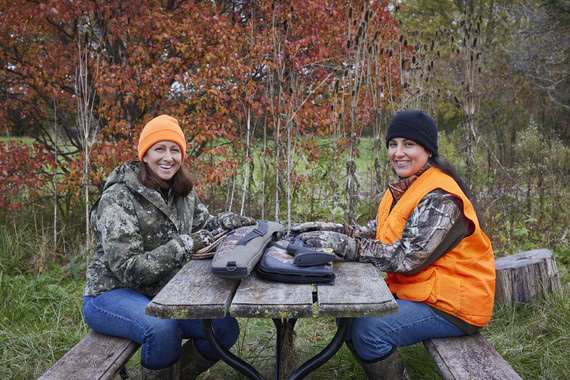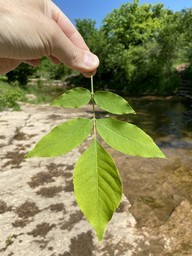Stay Safe This Hunting Season; Sign Up For A Hunter Safety Course

It’s never too early for new hunters to take a hunter education course or for experienced hunters to retake it as a refresher. / Photo Credit: Wisconsin DNR
Hunting season is right around the corner. New hunters can take the first step to finding an adventure in the field by signing up for a hunter safety class. And for experienced hunters, it’s a great time to retake it as a refresher.
More than 20,000 people take hunter education courses in Wisconsin each year. Anyone born on or after Jan. 1, 1973, must complete a hunter education course and have a hunter education certification on file to purchase any hunting license in Wisconsin unless hunting under the Mentored Hunting Law. Anyone aged 17 and under must complete an in-person course.
There are three ways to earn a hunter education certification:
- Online + Field Day – In this class, students complete training both online and in-person with one day of training with a certified instructor. This class is a good fit for a person who has handled firearms or is planning to hunt with someone with more experience to learn from. There are 4 to 6 hours of firearm handling opportunities in this class. All age groups are welcome.
- Traditional Class – This class offers students a more hands-on approach, as they will work with a certified instructor over a few days. Most students and families enjoy this option because they can do it right in their community. This option provides students with opportunities to handle hunting equipment and covers topics like safe hunting practices, shooting and more. In-person feedback from instructors also enhances student learning. All age groups are welcome.
- Online Only (18+ Only) – Students who choose this option spend multiple hours studying and completing modules online. A passing score on the final exam is necessary to be certified. This option is a great fit for students with a connection or mentorship within the shooting sports to help establish and strengthen their skills and lessons learned. This course is only for those aged 18 and above.
Before enrolling in any course, interested students must first obtain a Wisconsin Customer ID number.
For more information on course options, links to enroll and cost, visit the DNR’s Outdoor Skills Safety Education webpage.

Help Count Chimney Swifts Before They Migrate South
Chimney swift migration has begun for the season. We need your help to monitor populations and locate important roost sites as they head south. The call to count is part of Swift Night Out, a continent-wide effort held to raise awareness about the decline of chimney swifts.
According to the Wisconsin Chimney Swift Working Group, after swifts have finished raising their young, they gather in groups at communal roosting chimneys before beginning their fall migration to South America. While migrating through Wisconsin from mid-April to early May, you can find large numbers of chimney swifts and hear their chittering sounds in the early evenings, ready to roost overnight in brick chimneys.
“Volunteers all over the state of Wisconsin have counted thousands and thousands of swifts roosting in chimneys over the past decade,” said Nancy Nabak, chair of the Wisconsin Chimney Swift Working Group. “It’s fascinating to watch, count and listen to swifts as they circle and whirl above chimneys before they roost for the night – it’s a visual sky concert.”
Although volunteers have counted large numbers of swifts since the program began, they’ve also documented the loss of many chimney swifts due to the demolition or capping of chimneys, resulting in a loss of habitat for this federally protected bird. The Wisconsin Chimney Swift Working Group hopes to bring attention to finding ways to protect existing chimneys, therefore protecting the chimney swift population.
Last year, the Wisconsin Chimney Swift Working Group partnered with the U.S. Fish & Wildlife Service to create a cost-share program to preserve swift chimneys in need of repair. Through the program, the Vernon County Historical Society successfully restored a chimney at the Vernon County Historical Museum in Viroqua, which hosts hundreds of swifts. Those who know of a chimney that needs repair and currently hosts swifts are encouraged to contact the working group via email at helpchimneyswifts@gmail.com.
Chimney swifts nest in eastern North America in the summer and migrate to South America in the fall, where they gather by the hundreds. Before European settlement, the birds nested in large hollow trees in old-growth forests. As these forests disappeared, the birds discovered brick chimneys as a replacement. Brick chimneys work well for the birds because they provide enclosed areas with a rough, vertical surface the birds can cling to, much like a hollow tree. Unlike most birds, chimney swifts do not perch on branches but use the sharp nails on their tiny feet to cling to the sides of their roost.
According to the latest North American Breeding Bird Survey, the chimney swift population has declined by 72% in the past 50 years. Specific reasons for this loss are unknown, but pesticides, climate change and habitat loss likely all play a role.
Chimney swifts have slender bodies with long, curved wings and short, stubby tails (they look like a flying cigar or boomerang). They fly rapidly with nearly constant wing beats, often twisting from side to side. They also give a distinctive, high chittering call while in flight. They are the only bird that will drop into chimneys to roost for the night.
Here’s how you can help:
- Look for tall brick chimneys that are uncapped. If you find more than one chimney, do some scouting in the evenings to determine where the swifts will roost. Watch for swifts swooping over the chimney for a while before they enter. Be aware that the roost site choice can change from night to night, especially during migration.
- Pick one or more nights to monitor through September.
- Observe the roost starting roughly 20 minutes before sunset until 10 minutes after the last swift enters the chimney. Stay in one location, even if you do not see swifts right away. They may come to your site later, and you do not want to miss them. To be sure, stay 30 minutes after sunset to know if it was active or not. If you have zero swifts in your chimney, please record this because it is still valuable information.
- Count (or estimate) the number of swifts as they enter the chimney. It’s useful to count in groups of five or 10 when they enter quickly in large numbers. A handheld clicker counter can be helpful.
- Submit your data to eBird.org. Please note that a free eBird.org account is required to log in and submit your data. Map your roost site to an exact address or point when prompted for a location. After you enter the number of chimney swifts, use the hashtag #SwiftWI in the chimney swift details section, making your data submission easier to access.
- You can add additional information in the chimney swift details section, in this exact order, with semicolons separating the data: #SwiftWI; the type of building (residence, school, church, business, hospital, apartment, swift tower/structure, etc.); the condition of the chimney (in good shape, in need of repair); any other notes (example: #swiftwi; residence; chimney in need of repair; any other notes).
Find more information about chimney swifts and how to help protect them locally on the Wisconsin Chimney Swift Working Group website.
Photo Credit: Nancy Nabak |

Avoid Ash Trees When Placing Deer Stands
As hunting season quickly approaches, it’s a great time to start prepping for the season. If you head out to find the perfect spot for your tree stand this weekend, you’ll want to avoid placing it in or near ash trees this deer season as they start scouting properties.
Most ash trees in the southern half of Wisconsin, Door County and the Mississippi River counties are dead or dying from emerald ash borer infestation. Although emerald ash borer is not as widespread in other parts of the state, the invasive insect continues to be found at additional locations throughout the state and unreported infestations are also likely present.
Tree stand accidents are the leading cause of serious injury to deer hunters. Research shows one in four bowhunters have experienced a fall or near-fall from an elevated stand.
It is important to place and maintain tree stands carefully, as trees infested with emerald ash borer may unexpectedly snap or drop large branches. Hunters should also be cautious around ash trees when on the ground, especially in windy conditions, as infested trees are susceptible to branch and stem breakage.
Basic Rules Of Treestand Safety
No matter the type of treestand, follow these basic safety rules:
- Always wear a full-body harness also known as a fall-arrest system. Connect to your tether line and keep your tether line short. The tether is designed to keep you in the seat, not to catch you after you fall.
- Always have three points of contact while climbing into and out of the treestand, including two hands and one foot or two feet and one hand at all times.
- Always use a haul line to raise and lower your unloaded firearm or bow into and out of the stand. You can also use the haul for other things like a heavy backpack.
- Use a lifeline when climbing up and down, this keeps you connected from the time you leave the ground to the time you get back down.
Additional treestand safety information is available here. |

How To Identify Ash Trees
Ash trees can be identified through two key features: opposite branching patterns where two branches come off the main stem directly across from each other and compound leaves with 5-11 leaflets.
More information on ash trees and how to identify them is available on the UW-Madison’s Department of Entomology Emerald Ash Borer in Wisconsin webpage.
Avoid Spreading Forest Pests And Diseases
When traveling for hunting season, obtain firewood close to where it will be burned in order to reduce the chance of spreading tree-killing insects and diseases such as emerald ash borer, spongy moth and oak wilt.
Dry firewood with loose bark has the lowest risk of spreading harmful insects or diseases. Purchasing certified firewood is another option, as it is widely available and is seasoned or treated to eliminate pests and diseases. Bundles of certified firewood have a printed label showing certification.
More information about emerald ash borer, signs and symptoms of infestation and where this pest has been found is available on the DNR website.
|
|
